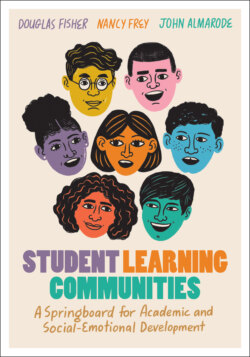Читать книгу Student Learning Communities - Нэнси Фрей - Страница 5
На сайте Литреса книга снята с продажи.
Why Student Learning Communities Matter
Оглавление. . . . . . . . . . . . . . . . . . . .
What teacher hasn't experienced group work gone bad?
We all know that we're supposed to have students collaborate with one another, but this practice is so often fraught with problems. One student does all of the work while others observe or, worse, disengage. Groups divide and conquer the task, and members don't ever interact with one another. Students talk about whatever they want when the teacher is not nearby and, consequently, do not finish the task. What starts as fun interaction devolves into a chaotic carnival disconnected from learning objectives. The task is so easy, or so difficult, that students are so bored or so frustrated that they simply don't do it. Every one of these situations may be familiar to you from past efforts to create opportunities for students to learn with and from one another. And if you've ever designed a group project gone awry, you're probably nodding in agreement right now.
Yes, the promise of student-to-student collaboration is often at odds with what actually goes on in our classrooms. Maybe the following experience, described by mathematics teacher Grace Coates (2005), is familiar to you as well?
Where I had imagined cooperative dialogue, there was bickering and arguing over materials. Where I had envisioned smiles, many students wore sullen looks. A few wore triumphant smiles as they managed to take over the work or materials. Where I had hoped for thoughtful curiosity, there were pleading looks saying, "What do I do?" I was so disappointed by these results and my inability to change things in a way that would get my students working productively. (p. 11)
What was missing in Coates's classroom, and what is often missing in group work, are not just the principles that build community and preserve focus but also the skills that allow students to benefit from the experience. Coates admits that she originally believed just putting students in groups would result in better learning. She came to realize more was required. Her students needed to learn how to communicate with one another over a meaningful task. They needed to know what success looked like and how to support each other in the pursuit and attainment of that success.
Instead of assuming that the group work students are doing is good enough, instead of hoping that collaboration will be its own reward, and instead of holding our breath every time group work starts in the hope that it will be productive, what if teachers structured that work more intentionally and purposefully? What if we equipped students with the skills and conditions they need to learn in a way that is truly collective and does make them "smarter together" than they would be as individuals?
The learning process requires the active involvement of the learner (Bransford, Brown, & Cocking, 2000). Decades ago, education was largely focused on acquisition of knowledge, with little consideration given to what went on in the minds of learners. The cognitive sciences and the emergence of awareness of metacognition (thinking about one's thinking) have since helped teachers divine how students are processing and manipulating information. Increasingly, our aim is not for students to simply recall and recognize information; these are entry points, not destinations. Our goals for students, the destinations we set and endeavor to help them reach, include cognitive learning outcomes, conceptual understanding, creative problem solving, the development of communication skills, and social-emotional outcomes. In the end, outcomes today are measured in terms of transfer of learning—that is, the ability to apply knowledge in new situations to meet new challenges (Bransford et al., 2000).
Student learning communities (SLCs) are a way to recalibrate "group work" to transcend the format's traditional limitations and pursue these essential modern outcomes. It's a model dependent on the active involvement of each member of a learning team and designed to combine the skills and insights of each member in a way that allows all members to learn deeply and collectively.
In the spring of 2020, when distance learning came to dominate teachers' lives, many of us became newly cognizant of just how important it is for students to learn with and from one another. Yes, collaboration had long been identified as a "21st century learning skill" necessary for "the workforce of the future"; two decades into the century, it seems the future really has arrived. It means working from home instead of classrooms and offices. It means connecting with, solving problems with, and learning from others virtually instead of in person. We have also seen how the physical separation of students from their peers leaves many feeling isolated. We have recognized the toll it takes on them (and on us, their teachers). As a result, we believe it is crucial to prioritize ways for students to interact meaningfully in virtual environments in order to mitigate some of these effects. And while the setting may be different in a physically distanced classroom space or an online learning platform, the principles of how people learn together are the same.
As an accompaniment to this book, we have created an additional resource designed to further deep collective learning in virtual environments. It is available as a free download at www.ascd.org/ASCD/pdf/books/SLCVirtual.
